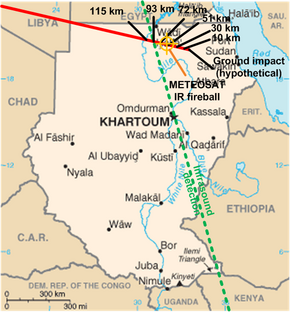 | |
| Discovery | |
|---|---|
| Discovered by | Catalina Sky Survey |
| Discovery date | October 6, 2008, 06:39 UTC |
| Designations | |
| 2008 TC3 | |
| Orbital characteristics[1] | |
| Epoch October 7, 2008 (JD 2454746.5) | |
| Uncertainty parameter 4 | |
| Observation arc | 1 day (575 observations) |
| Aphelion | 1.71644 AU (256.776 Gm) |
| Perihelion | 0.899957 AU (134.6317 Gm) |
| 1.308201 AU (195.7041 Gm) | |
| Eccentricity | 0.312065 |
| 1.50 yr (546.53 d) | |
| 330.7541° | |
| 0.6587071°/day | |
| Inclination | 2.54220° |
| 194.101138° | |
| 2008-Nov-20 | |
| 234.44897° | |
| Jupiter MOID | 3.57975 AU (535.523 Gm) |
| Physical characteristics | |
| Dimensions | 4.1 meters |
| Mass | 80 tonnes (80,000 kg) |
Mean density | ~1.5 g/cm3 |
| 0.0269409 h (1.61645 min)[1] | |
| 0.1±0.03 | |
| F/M | |
| 30.4[1] | |
2008 TC3 (Catalina Sky Survey temporary designation 8TA9D69) was an 80-tonne (80-long-ton; 90-short-ton), 4.1-meter (13 ft) diameter asteroid[2] that entered Earth's atmosphere on October 7, 2008.[3] It exploded at an estimated 37 kilometers (23 mi) above the Nubian Desert in Sudan. Some 600 meteorites, weighing a total of 10.5 kilograms (23.1 lb), were recovered; many of these belonged to a rare type known as ureilites, which contain, among other minerals, nanodiamonds.[2][4][5]
It was the first time that an asteroid impact had been predicted before its entry into the atmosphere as a meteor.[6]
- ^ a b c "JPL Small-Body Database Browser: (2008 TC3)" (last observation: October 7, 2008; arc: 1 day). Jet Propulsion Laboratory. Retrieved March 28, 2016.
- ^ a b Jenniskens, P.; et al. (2009). "The impact and recovery of asteroid 2008 TC3". Nature. 458 (7237): 485–488. Bibcode:2009Natur.458..485J. doi:10.1038/nature07920. PMID 19325630. S2CID 7976525.
- ^ Plait, P. (October 6, 2008). "Incoming!!!". Bad Astronomy. Archived from the original on October 7, 2008. Retrieved October 8, 2008.
- ^ Chang, K. (March 25, 2009). "Recovered Pieces of Asteroid Hold Clues to Early History". The New York Times. Archived from the original on November 13, 2013. Retrieved March 26, 2009.
- ^ Borenstein, S. (March 26, 2009). "Astronomers catch a shooting star for 1st time". ABC news. The Associated Press. Archived from the original on March 29, 2009. Retrieved September 15, 2009.
- ^ Roylance, F. (October 7, 2008). "Predicted meteor may have been sighted". Maryland Weather. Archived from the original on October 10, 2008. Retrieved October 8, 2008.